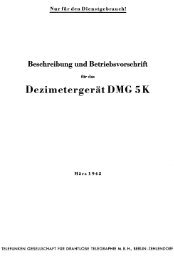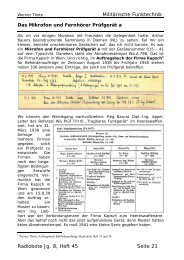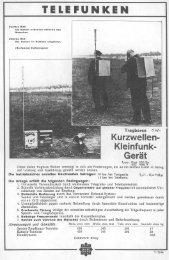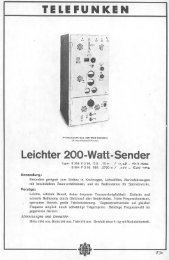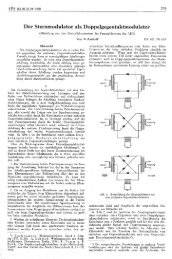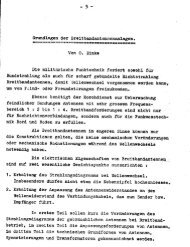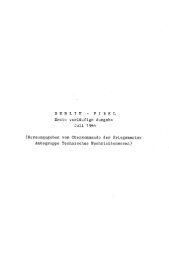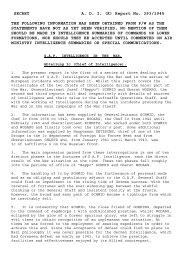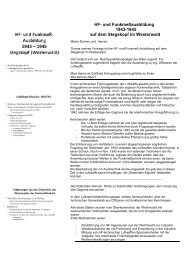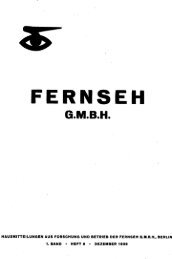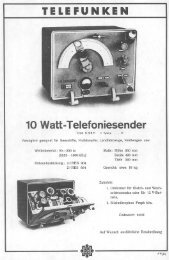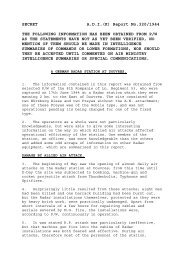SECRET A. D. I. (K) Report No. 357/1945. THE ... - Cdvandt.org
SECRET A. D. I. (K) Report No. 357/1945. THE ... - Cdvandt.org
SECRET A. D. I. (K) Report No. 357/1945. THE ... - Cdvandt.org
You also want an ePaper? Increase the reach of your titles
YUMPU automatically turns print PDFs into web optimized ePapers that Google loves.
<strong>SECRET</strong> A. D. I. (K) <strong>Report</strong> <strong>No</strong>. <strong>357</strong>/<strong>1945.</strong><br />
<strong>THE</strong> FOLLOWING INFORMATION HAS BEEN OBTAINED FROM P/W. AS <strong>THE</strong><br />
STATEMENTS MADE HAVE NOT AS YET BEEN VERIFIED, NO MENTION OF <strong>THE</strong>M.<br />
SHOULD BE MADE IN INTELLIGENCE SUMMARIES OF COMMANDS OR LOWER<br />
FORMATIONS, NOR SHOULD <strong>THE</strong>Y BE ACCEPTED AS FACTS UNTIL COMMENTED<br />
ON IN AIR MINISTRY INTELLIGENCE SUMMARIES OR SPECIAL<br />
COMMUNICATIONS.<br />
RADIO AND RADAR EQUIPMENT IN <strong>THE</strong> LUFTWAFFE - II<br />
Navigational Aids.<br />
1. This report is the second of the series dealing with radio and radar equipment in the<br />
Luftwaffe.<br />
2. As in the case of the first of the series (A.D.I.(K) 343/1945) dealing with Blind Landing<br />
and Airborne Communications Equipment, it is based on interrogation of General<br />
Nachrichtenführer MARTINI, Director General of G.A.F. Signals, and a few important<br />
members of his staff, and has been supported by a file of current papers which were in the<br />
possession of the General’s Chief of Staff.<br />
3. An index of the numerical designations of the navigational equipment mentioned in this<br />
report appears in Appendix I.<br />
4. For convenient reference, a translation of the document entitled "Funkausrüstung der<br />
Flugzeugmuster, <strong>No</strong>tprogramm" (signal Equipment in the G.A.F. - Emergency Program) - item<br />
45/99 ff in A.D.I.(K) Documents List 45/9 - which has also appeared as an Appendix to<br />
A.D.I.(K) 343/1945, is reproduced as Appendix II to the present report but the list of equipment<br />
contained in that document has been omitted as Appendix I gives a fuller list.<br />
TRENDS OF DEVELOPMENT.<br />
5. Throughout the course of the war, the general standard of German navigational training was<br />
undoubtedly inferior to that of the Allies. A simple form of navigation was taught but<br />
navigators track plotted only and relied on W/T aids and in particular positioning by means of<br />
loop fixes as the main basis for their navigation.<br />
6. During the early part of the war extensive use was made of Knickebein and other beam<br />
systems, but later this form of navigational aid gave way to the "Y" control system (better<br />
known by the Allied codeword Benito) and "Egon".<br />
7. Sonne was universally accepted as an outstanding success and from the time of its inception<br />
in 1942 research was continuously directed towards overcoming its imperfection, in particular<br />
the range limitation. Komet was a typical example, of attempted improvement on these lines<br />
8. The Germans were patently backward in the field of pulse systems and the majority - if not<br />
all - of their navigational aids of this type were copied from Allied methods.
9. The fear of the Allied countermeasures was much to the fore during the last two years and<br />
considerable research and efforts was devoted to offsetting such interference and to perfecting<br />
systems which would reduce and if possible preclude the danger of jamming. Another factor<br />
always present in the minds of those responsible for tactical navigational requirements was that<br />
the apparatus must be as light and small as possible because of the limited space available in<br />
German aircraft.<br />
10. During the last stages of the war, and as a natural consequence of German air policy, being<br />
forced to concentrate on the defensive, thereby involving almost exclusive use of fighter power,<br />
a great deal of attention was devoted to the development of simple navigational aids suitable<br />
for single-engine aircraft of which Rübezahl was a typical example.<br />
D/F LOOP EQUIPMENT.<br />
PeGe (Peil Gerät) 6.<br />
11. PeGe 6 was the successor of PeGe 5, the standard loop D/F, set in use at the beginning of<br />
the war, and. operated on 150 - 1200 kc/s (2000-250 meters). It provided automatic D/F<br />
facilities, the W/T operator merely having to tune to the signal and the "answer" being produced<br />
on a course indicator.<br />
12. In the opinion of P/W, who was responsible for operational requirements in the<br />
navigational field and who had had fairly extensive navigational experience with K.G.40,<br />
PeGe 6 was less reliable than the manually-operated PeGe 5 as the automatic D/F facilities<br />
could not distinguish between the true signal and jamming and were apt to record bearing midway<br />
between the two if they were near together. The human ear was much more acute and<br />
could distinguish the minimum of the real signal from that of the "phoney” one. It had the<br />
further disadvantage that it was a heavier piece of equipment than the manually operated set.<br />
FuGe 141<br />
13. The FuGe 141 operating on a frequency band of 58.0 - 59.2 mc/s was a receiver with a D/F<br />
loop fitted to Air Rescue aircraft used for homing on to the NS 4 emergency radio set carried on<br />
the chest by pilots.<br />
14. The NS 4 had a flexible steel tape aerial and batteries which gave it an endurance of 2 to<br />
2,5 hours.<br />
FuGe 142.<br />
15. The FuGe 142 using the 2000 - 250 metre band was a small D/F battery set for use in<br />
emergency in the event of failure of the aircraft' s electricity supply.<br />
16. The FuGe 142 had a manually-operated loop and its accuracy was only 10° to 15°.<br />
17. When the P/W who, in October 1944, took over the navigational tactical requirements first<br />
made its acquaintance, he discovered that the designer of the emergency set, while having the<br />
laudable object of assisting a crew in dire emergency when they where probably well and truly<br />
lost, had omitted to include any sensing arrangement. The set was, therefore, quickly scrapped<br />
as being as much of a danger as an aid.
FuGe 145<br />
18. The FuGe 145 was a simple type of D/F set in development for use in single-seater aircraft.<br />
It was for use with M/F beacons and was designed for use by coastal reconnaissance aircraft, as<br />
for example the Do.335, so that they could obtain a bearing when flying at low level.<br />
19. It was much lighter than the PeGe 6 and had no automatic facilities, but was very easy to<br />
operate. P/W had thought that it might ultimately supersede the PeGe 6 for other types of<br />
aircraft.<br />
Suggested loop for fighter aircraft<br />
20. The research centre at Rechlin had been asked to examine a rough type of loop for singleseater<br />
fighter aircraft, which would consist of a loop built into the pilot' s helmet. It was thought<br />
that this would enable the pilot to establish the general direction of a beacon by movements of<br />
his head and without recourse to the use of a compass.<br />
21. This idea was tried out and seemed promising, but was never fully developed.<br />
HOMING BEACONS.<br />
Schwanboje.<br />
22. The Schwanboje was a waterborne V.H.F. beacon dropped by parachute and originally<br />
used by K.G.40 for marking convoys or submarines. In the autumn of 1944 a 1ine of Schwan<br />
buoys was used to aid the He.111's when launching V-1’s from the <strong>No</strong>rth Sea against this<br />
country.<br />
23. The beacon consisted of a frame aerial and transmitted on a wavelength which could be<br />
homed on by the FuGe 17, the standard equipment of K.G.40 in 1942 when the Schwanboje<br />
came into use.<br />
24. The set was powered by accumulators and had a live of five hours; by the means of a<br />
clockwork device it could be pre-set before release so that it ran for a testing period<br />
immediately on release and later started up again after a prescribed interval governed by the<br />
expected time of arrival of the homing aircraft. The buoy was fitted with a self-destroying<br />
charge operated automatically.<br />
25. A later type of Schwanboje operated on the 38 - 42 mc/s waveband so that aircraft<br />
equipped with the FuGe 162 could also use the system.<br />
Biene<br />
26. Biene is the code word for a responder beacon. The idea of responder beacons for homing<br />
purposes had only been hit on in 1944 and Bienen to respond to the different airborne radar sets<br />
were still under development in <strong>1945.</strong> The FuGe 243 - Hohentwiel Biene – had been used by<br />
coastal units in <strong>No</strong>rway, in February or March <strong>1945.</strong>
27. Responder beacons were also being developed for use in the Baldur method of navigation<br />
(see paragraphs 79, 82 of this report).<br />
BEAM SYSTEMS.<br />
Zyklop.<br />
28. This was the latest form of the well-known Knickebein working on 30 - 33,3 mc/s and<br />
received by E.B.L.3 in the aircraft. It was a mobile station which could be fully erected into<br />
operation within a week.<br />
29. A still more mobile unit known as the Bock-Zyklop had been introduced. This could be set<br />
up in three days and could be adapted for use on the FuGe 16 frequency although as yet,<br />
according to documents, no visual indicator for the FuGe 16 had been developed.<br />
30. The 120 W ground transmitter was called the ???? which gave a beam 0.5° wide and a<br />
range of 300 km. at a height of 5,000 meters. The Zyklop systems had been made use of on the<br />
Russian front up to the end of the hostilities.<br />
Sonne.<br />
31. The Sonne beacon system which worked on a frequency of 270 - 480 kc/s was received in<br />
the aircraft on the FuGe 10. It was considered an extremely effective daylight system but the<br />
range limitation was a disadvantage. Fixes could be obtained from ranges up to 1,000 - 1,200<br />
km. Sonne 6 at Quimper which was the most efficient of the Sonne beacons, had been used on<br />
an occasion at a distance of 1,400 km.<br />
32. The sectors served by Sonne covered, an angle of 120 – 150°. The beacon was very reliable<br />
over the centre sector of 100°, but the error increased progressively towards the edges of the<br />
beam in conformity with the sine law.<br />
33. At night errors up to 4° were liable to occur even in the centre of the sector of the beacon<br />
and no real use could be made of it.<br />
Mond.<br />
34. To improve the Sonne beacons both in range, and accuracy, an experimental system<br />
working on the same principle, but on 3000/6000 kc/s was tried out in 1942. The shorter wave<br />
transmission did not prove very reliable and was given up about the end of 1943.<br />
Stern.<br />
35. Finally a beacon of the Sonne type under the name "Stern" was designed for use on a V.H.<br />
frequency. It, not unnaturally, only gave optical range and was, therefore, of no practical value<br />
and was not developed.<br />
Dora.
36. One P/W had seen documentary mention of Dora which he believed was a navigational aid<br />
system and a precursor of Komet. He did not know whether it worked on the same principle but<br />
the Komet experimental site at Kolby was on the former Dora site.<br />
Komet.<br />
37. In 1942 the question of navigation over the Atlantic stood in the limelight . As the He 177<br />
was supposed to be coming into service shortly to enable K.G.40 to reach further West, the<br />
need for navigational equipment of longer range became acute.<br />
38. A year or so earlier Professor von HANDEL had categorically stated in a lecture that a<br />
long-range navigational system based on pulse would inevitably be extremely inaccurate.<br />
In view of Professor von HANDEL's views on pulse systems, an improved form of Sonne<br />
which would give much greater ranges and be less susceptible to night effect was given high<br />
priority.<br />
39. The system evolved was called "Komet" and experimental stations were erected at<br />
Bordeaux and Kolby (see A.D.I.(K) 364/1944). The ground station called for an array of no less<br />
than 127 masts and 19 control huts in order to cover a 90° sector. It worked admirably provided<br />
a 10° sector only was covered, but as soon as the planned 90° sector was put into operation,<br />
mutual interference between the masts arose and the various lobes radiated were no longer of<br />
symmetrical pattern, with the result that large errors crept in.<br />
40. Research on this delayed the project considerably. After the invasion when long distance<br />
reconnaissance in the Atlantic was no longer practical politics, the Komet system was given up<br />
without ever having been effectively used. The development people were the more pleased to<br />
dispense with it since it left the German radio research and industry free to deal with other more<br />
urgent matters.<br />
41. The beacon was to operate on frequencies of 5000, 9000 or 12,000 kc/s received on the<br />
FuGe 10K, and it was estimated that ranges up to 3000 km would be obtained. The system<br />
employed was to be similar to that used in the Sonne but instead of obtaining one reading per<br />
minute, oscillation of the beam was to be speeded up to give 100 readings par minute.<br />
42. The true bearing of the aircraft was automatically recorded by the FuGe 124 which was<br />
known as the Kometschreiber. The recording took the form of a series of vertical lines, one for<br />
each reading, printed on a strip of paper. At the same time as the lines were printed the<br />
Kometschreiber recorded the section of the swept area in which the aircraft was flying, thus<br />
giving what amounted to a rough position.<br />
43. The fine reading was obtained from the length of the recorded lines. Any inaccuracies due<br />
to night effect could be easily eliminated by averaging the length of the lines, as recorded, on<br />
the paper strip, by eye.<br />
Erika.<br />
44. Erika was a navigation system (see A.D.I.(K) 364 and 409/1944.) which had already<br />
reached the development stage in 1942 but its operational employment was of brief duration<br />
and it was soon discarded in favour of Bernhard.
45. Erika was based on the principle of a V.H.F. (30 - 33 mc/s) beam oscillating rapidly over a<br />
segment of about 60 – 90°. The beam was phased, a different phase being picked up in different<br />
sections of the segment and read off in relation to a standard phase producer in the aircraft. In<br />
order to obtain a fix, two such Erika stations had to be received and to receive each station no<br />
less than two E.B.L.3's were necessary making a total of four receivers.<br />
46. The range presentation unit in the aircraft, FuGe 121, took the form of a clock-face with a<br />
needle indicator and calibrated, P/W thought, from 0 -100. A specially prepared map was<br />
required to establish bearing.<br />
47. A disadvantage of Erika was the vulnerability to jamming, interference signals modifying<br />
the phase and thereby giving inaccurate readings. The great weight, carried and the bulk of the<br />
four receivers, which were particularly cumbersome in the relatively small aircraft in use in the<br />
G.A.F. made its widespread use impracticable.<br />
Bernhardine.<br />
48. This system was first introduced in 1942 for use by bomber aircraft, but was later dropped<br />
in favour of the Benito and Egon control systems. With the increasing British jamming during<br />
night raids it was reintroduced for use in night fighter commentary (see A.D.I.(K) 125/1945,<br />
paras.5 to 29), which it was thought could only be jammed with great difficulty.<br />
49. The term “Bernhard” was used for the ground stations whilst the airborne recording<br />
equipment was called Bernhardine or FuGe 120. The latter made use of the E.B.L.3. receiver as<br />
the transmissions lay in the 30-33 mc/s band.<br />
50. At the time of the German capitulation, the following three transmitting stations were in<br />
operation, the first two, of which could transmit commentary.-<br />
-Thisted, on N.W. coast of Denmark.<br />
-Bretstedt, N. of Husum, Germany.<br />
-Trebbin, S.E. of Berlin.<br />
51. A further station near Breslau had been almost completed when it had to be dismantled on<br />
account of the Russian advance. Additional stations were in the course of construction near<br />
Kassel, Munich, Pilsen and Vienna.<br />
52. The Bernhardine system was looked upon as a considerable improvement on Erika. It gave<br />
360° coverage as compared to 60/90° with Erika and, whereas from the jamming aspect stray<br />
signals could disturb the phase of Erika causing false indication, in the case of Bernhardine,<br />
interference merely resulted in no reading being possible, and furthermore to attain this through<br />
360° a very powerful jamming transmitter flying near the ground station would be needed.<br />
53. The Bernhardine system was not regarded as unjammable but it was thought that use of<br />
high power and aerial gain would render jamming by airborne means impracticable.<br />
54. In addition to the E.B.L.3 receiver, the airborne Hellschreiber FuGe 120, also called the<br />
Bernhardine, which gave both bearing and commentary was employed. According to P/W the<br />
FuGe 120 was large and weighty and the first improvement aimed at was to reduce the weight<br />
and provide a set which occupied less space in the aircraft. To this end an attempt was made to<br />
eliminate the use of paper strip for the Hellschreiber and a rotating "Folienschreiber" a
cellophane paper moving over a sticky carbon surface which constituted a self-eraser - was<br />
employed. This projected recording method proved a failure and the use of paper strip had to<br />
be reverted to. According to documents the type using paper strip was known as FuGe 120a,<br />
and the self-erasing recorder FuGe 120b.<br />
55. A smaller model, the FuGe 120k, to operate on the paper strip principle which constituted<br />
the latest improvement, was still in the development stage at the conclusion of hostilities.<br />
Previously the ground transmitter broadcast simultaneously from the upper and lower aerial<br />
arrays on two frequencies close enough to one another for them both to be received on one<br />
channel of the E.B.L.3. One lobe was used for coarse D/F, the other for fine. The two<br />
frequencies were then separated by a filter before being fed into the Hellschreiber. The FuGe<br />
120k was designed for use with a ground transmitter operating only on the coarse D/F<br />
frequency. The filter could therefore be dispensed with and considerable weight saved in the<br />
airborne set at the expense of some accuracy in D/F.<br />
56. With the loss of D/F accuracy the sharp “V” in the vertical printing indicating the reading<br />
(see diagram A.D.I.(K) 125/1945 para.18) became a gap about 4° wide. To facilitate the<br />
reading of the centre of the gap by eye, and to reduce the size and weight of the apparatus, the<br />
vertical lines referred to above were superimposed on the scale which could then only be read<br />
in the gap. This allowed the paper strip to be considerably narrower.<br />
57. The FuGe 120k was designed primarily for use in single seat jet aircraft but was also to be<br />
embodied in the Ju.88 where space was at a premium, as soon as sufficient numbers of this set<br />
were available.<br />
Hermine.<br />
58. The Hermine system was originally developed, in response to a tactical requirement<br />
formulated during the second part of 1942, as a navigational aid for the purpose of giving an<br />
approximate bearing to single-engine night fighters engaged on “Wilde Sau” operations.<br />
59. By the time the initial difficulties in development had been overcome Wilde Sau night<br />
fighting had almost ceased; it was found however that Hermine could be used to advantage by<br />
day fighters, and it came into operational use.<br />
60. An accuracy of ±5° was assumed, but it was found in practice that this could be improved<br />
upon to ±3° by experienced pilots.<br />
61. Thirteen or fourteen ground stations were in operation by Easter 1945 which, P/W claimed,<br />
gave complete coverage of the Reich. It was intended to fit two Schlechtwetter (bad weather)<br />
Fighter Geschwader with the necessary airborne equipment, and this program had been onethird<br />
completed by May <strong>1945.</strong> One P/W had heard that ten to fifteen Me.262's of K.G.51 were<br />
amongst the aircraft so equipped.<br />
62. The following may be added in modification of the description of the Hermine system<br />
given in A.D.I.(K) 125/1945, paras.59 to 62. The Hermine rotating beacon transmits a<br />
continuous tone on which is superimposed a speaking clock which counts from 1 to 35, each<br />
figure representing tens of degree. Over an angle of about 15° the continuous tone falls to a<br />
minimum and rises again. During this period the voice appears to become more audible and the<br />
pilot can estimate where the minimum of continuous tone occurs, and so obtain his bearing<br />
from the beacon.
63. The beacon recognition is given by means of a self-evident code name for example,<br />
"Berolina” for Berlin – which is spoken by the voice in place of 000°.<br />
64. The airborne equipment is the FuGe 125 consisting of the E.B.L.3 with the Tzg<br />
(Telephoniezusatzgerät) which enables the 30.0 - 33.3 mc/s transmission picked up on the<br />
E.B.L.3 receiver to be heard in the pilot's headphones. Though the Hermine beacons were fully<br />
operational there was a scarcity of FuGe 125 sets, as a result of which practical experience of<br />
this system was too limited to judge of its efficiency or to lead to further improved tactical<br />
requirements been formulated.<br />
PULSE SYSTEM.<br />
Ingolstadt<br />
65. All the P/W had heard reference to Ingolstadt and agreed that it was a long-range<br />
navigational system.<br />
66. One P/W thought that Ingolstadt was the cover name for a pulse navigation system using<br />
hyperbolic curves and similar to British Gee; it was originated by Telefunken in 1938 but was<br />
then turned down by the R.L.M. In his recollection the original Telefunken idea derived from<br />
theoretical discussions at an international conference before the war.<br />
67. As mentioned earlier under the heading of Komet, Professor von HANDEL maintained that<br />
owing to the incidence of mutual interference between direct and reflected waves the system<br />
was impracticable at long range. In consequence of von HANDEL’s view the system was<br />
dropped.<br />
68. Much consternation and annoyance was occasioned in 1944, when it was found that the<br />
Allies were successfully operating a similar system.<br />
69. Truhe is the cover name used to describe navigational aid system, using ground stations,<br />
similar to those of British Gee. In effect the British Gee stations were also used, the airborne<br />
sets being almost identical with the British Gee boxes.<br />
Truhe.<br />
70. There is no very distinct difference between "Truhe" and "Hyperbel". The latter term was<br />
originally coined to denote our Gee. It was also used when German aircraft equipped with<br />
British Gee sets made use of British ground stations.<br />
71. The British Gee chain was used successfully but it was realised that so soon as the<br />
Germans lost an aircraft, over England, a change would be made. The German "Y" service<br />
monitored the British ground stations to follow any change in Gee phasing and passed advice of<br />
such change to their aircraft by W/T.<br />
72. Truhe referred to the German system which was ultimately to cover the 20 to 100 mc/s<br />
band and employed various types of ground transmitters including Feuerhilfe, Feuerstein,<br />
Feuerzange and Feuerland. All these transmitters could also be used to jam our own Gee,<br />
further details of which will appear in a subsequent report on German Radio Countermeasures.
The original 46 to 50 mc/s system was known as Truhe I and the new 30 to 60 mc/s system as<br />
Truhe II.<br />
73. A chain of Truhe stations was built around Berlin, primarily for training purposes and there<br />
were in addition groups of ground stations in the Schwarzwald and in Pomerania. The last<br />
named was intended for operations against Russia and it is not known if the stations were<br />
destroyed before their capture.<br />
74. The airborne sets which were known as FuGe 122 covering 46-50 mc/s and FuGe 123<br />
covering 25-75 mc/s were replicas of the British Gee boxes and according to P/W were<br />
equivalent to British R.1324 and R.1355. These German sets were slightly smaller and more<br />
compact than the British sets.<br />
75. Truhe was used by F.A.G.2 and K.G.66, but up to the time of capitulation only a few<br />
FuGe 122 and FuGe 123 sets had been produced and only one R.F. box for the latter set.<br />
Baldur.<br />
76. The Baldur range-measuring system is comparable to the British G.H. and appears to have<br />
been imitated from it. It was referred to by P/W as “Egon in reverse" and was the only<br />
navigational system developed by the German by means of which an aircraft could measure<br />
distance from a known source as opposed to fixing itself by a position line. As the G.A.F. staff<br />
were still thinking in terms of a grandiose bomber policy as late as June 1944, it was intended<br />
for use by bomber aircraft for pinpointing targets and for accurate blind bombing.<br />
77. The wavelength employed was in the neighbourhood of 2-4 meters and fell in the SN 2<br />
band.<br />
78. Only two experimental transmitters, both located in Lower Silesia, were erected and one<br />
P/W maintained that this system never progressed beyond experimental trials by the<br />
manufacturers. It was eventually relegated to low priority owing to the virtual cessation of<br />
German bomber operations and the pressure of more urgent demands on radio research and the<br />
radio industry.<br />
79. The airborne equipment was known as the FuGe 126 which was made up of a transmitter to<br />
interrogate a ground responder beacon, a receiver and a presentation unit. The receiver and<br />
transmitter were SN 2 units, though P/W thought they might have been slightly modified for<br />
use with Baldur.<br />
80. From documents, the presentation unit appears to have been a modification of the<br />
Würzburg range measurement tube, and the accuracy is given as ± 100 meters at all ranges, but<br />
this was thought to be purely theoretical and P/W doubted whether it would have been possible<br />
to achieve this accuracy in actual practice.<br />
81. A smaller airborne set, the FuGe 126k (k = klein = small) was built for use by single-seat<br />
aircraft. In reducing the size and weight of the set, and making it pilot-operated, accuracy had<br />
to be sacrificed. P/W, who was responsible for putting up the tactical requirements, considered<br />
a clock-face presentation to be the ideal solution. It was expected that the accuracy of the<br />
FuGe 126k would then be of the order of 500 meters independent of range.
Baldur - Truhe<br />
82. It was planned to experiment on a combination of Baldur and Truhe (Gee) for use by<br />
bombers. The intention was to use a hyperbolic grid line of Truhe for the target approach. This<br />
could be pre-set, and the pilot could fly along it by keeping the blip centralised, and could<br />
ascertain his exact position along the line by measuring his distance from a Baldur beacon. This<br />
system was considered simpler particularly for a single-seater aircraft, than the method of using<br />
two hyperbolic grid lines or two distances from Baldur beacons. The first experimental sets<br />
were to be ready in the autumn of this year.<br />
Baldur - Bernhardine<br />
83. A further project was a combination of Baldur and Bernhardine to give simultaneous<br />
bearing and range. The range indication was to be obtained by the pilot pressing a knob when<br />
the range would appear in kilometres on a dial. This system was suggested for use by both day<br />
fighters and bombers.<br />
GROUND CONTROL SYSTEMS,<br />
Benito.<br />
84. The Benito system of control using FuGe 16, known to the Germans as "Y", is too well<br />
known to warrant description. The following paragraphs deal with recent developments.<br />
85. When operating the bomber Benito procedure with the narrow beam. (0.3°) essential for<br />
azimuth accuracy, it was easy for the bomber pilot to get on to one of the side lobes in error<br />
since these were only about 3° from the main beam.<br />
86. In order to minimise the possibility of mistake and to relieve the pilot of the strain of flying<br />
on a beam, an automatic device, the FuGe 28a, was in use which was the improved and final<br />
form of the old Y-Gerät of 1941. Documents dated about June 1944 show that it was used in<br />
conjunction with FuGe 17, but P/W thought that it had been modified for use with FuGe 16ZY<br />
as well.<br />
87. The procedure was that the bomber pilot flew on instructions conveyed over the FuGe 17<br />
until it had been established by ground D/F stations that he was on the true beam, when the<br />
code word "Bako" would be given whereupon the pilot would switch on the FuGe 28a which<br />
took over control of the automatic pilot and kept him on the beam.<br />
88. P/W gave the accuracy of range measurement with the Bomber Benito procedure as only<br />
± 1 km. at maximum range.<br />
Egon.<br />
89. The original Egon procedure which involved the use of two Freyas, the one for rough<br />
positioning and the other for fine positioning - later became known as "Egon Einstand" (One<br />
location) to differentiate from an improved system termed “Egon Zweistand”<br />
90. Egon Zweistand was evolved to offset the inaccuracies in azimuth D/F, and cash in on the<br />
range accuracy of radar. With Zweistand a third Freya was introduced, placed some
considerable distance from the other two Freyas in order to give a distance cut. It was intended<br />
for use by bomber aircraft operating over England or on long range sea missions.<br />
91. The original Zweistand system, which was first tried out in Italy by a Schlacht unit, was<br />
somewhat primitive in that the readings from the extra Freya were telephoned through to the<br />
plotting centre and worked out before being plotted on the Seeburg table.<br />
92. To eliminate the delay thereby involved a landline connection was introduced to feed the<br />
Freya pulse to the C.R.T., which then had two blips showing ranges from the two Freya sites.<br />
The vulnerability of landline to disturbance and destruction later led to the development of a<br />
W/T transmitter and this method was employed successfully in operations.<br />
93. Since the Freya pulse was not strong enough to trigger off the FuGe 25A at ranges<br />
exceeding 250 kilometres, it was planned to supplant the Freya by extra powerful<br />
Wassermanns, and thereby increase the effective range of Egon Zweistand to 350 kilometres.<br />
94. A further line of development was the provision of a new type of control table giving the<br />
exactitude of plotting necessary for pinpoint bombing. This control table, which was under<br />
development at Rechlin, made use of complicated mechanical apparatus for accurate projection<br />
of the position of the bomber. One of these tables was destroyed in the course of a daylight air<br />
attack on Rechlin in February 1945; two other tables were in existence at the time of the<br />
capitulation, and were located somewhere in Western Germany.<br />
95. Egon when first introduced was received with some scepticism by the crews, as it was felt<br />
that it was too vulnerable to jamming. After it had been used operationally without being<br />
jammed in the attacks on London in March 1944, the procedure was adopted with greater<br />
confidence, and it gained a good reputation. As recounted in A.D.I.(K) 343/1945, Egon was<br />
always favoured by the R.L.M. technical development section in preference to Benito control.<br />
96. A drawback of the system was its restricted range at low altitude, which according to P/W<br />
was the reason why it was not used in conjunction with V.1 operations.<br />
Nachtlicht<br />
97. The Nachtlicht system was the first method of control not using R/T speech to be<br />
improvised by the Germans, and had been tried out during the raids on London in the spring of<br />
1944.<br />
98. It had been observed that the red signal lamp of the FuGe 25A was illuminated when the<br />
aircraft was being swept by a Freya, and it was suggested that use could be made of this as a<br />
means of transmitting morse signals from the ground. A Freya operating on a special<br />
wavelength, which P/W thought was 2.55 meters, was set up on the Channel coast and was used<br />
to send simple instructions to the aircraft attacking London by means of visual morse<br />
indications on the lamp of the FuGe 25A.<br />
99. The primitive method of giving distant control indications was the forerunner of<br />
"Nachtfee", "Barbara" and "Barbarossa".
100. Luftkurier was the first development of the Nachtlicht idea. It was primitive device<br />
intended to give visual indication to the pilot by means of a pointer which was started and<br />
stopped by the reception of pulses.<br />
101. P/W thought that Luftkurier was first tried out by K.G.66 on the Freya band, but it was so<br />
easy to jam by the addition of extra pulses that it was never developed.<br />
Nachtfee<br />
102. Nachtfee was the term used to describe a system for the transmission of control<br />
instructions to a pilot in the beam of the controlling Freya through the medium of a C.R.T.<br />
indicator similar to the Lichtenstein range tube. The airborne equipment used was known as<br />
FuGe 136 and weighed 12 kg.<br />
103. The original purpose of Nachtfee was, to provide a solution to the jamming of R/T control<br />
systems, and it had been used operationally by the Pathfinders of K.G.66 for mines in the<br />
Scheldt estuary. It was to be adapted for use by night fighters to overcome our jamming of the<br />
night fighter commentary.<br />
104. Nachtfee was a system using the FuGe 25A as receiver.<br />
105. The presentation screen in the aircraft was inscribed with various commands both on the<br />
inside and outside of a circular time trace. There was a stationary zero blip in the 12 o'clock<br />
position, and when an instruction was radiated the pulses received caused a second blip to<br />
emerge from the first and travel round the C.R. tube in a clock-wise direction, presumably by a<br />
slight change in p.r.f. This blip came to a stop and the command corresponding to its position<br />
could be read off on the inside of the time trace where a total of about eight different<br />
instructions were inscribed. It took from one to two second, for the blip to travel round the<br />
tube.<br />
106. It was thought that the further eight commands inscribed on the outside of the time trace<br />
were denoted by the blip making a complete circle starting round a second time before coming<br />
to rest at any one of the eight sectors. In this way a total of sixteen different orders could be<br />
given. For night fighters such instructions as "turn left/right", "climb", "dive”, etc. appeared on<br />
the inner side and figures for transmitting bearing on the outer side of the trace.<br />
107. This system was used operationally, but it was found that, apart from the susceptibility to<br />
jamming, other pulse transmissions could interfere by unlocking the system and thereby cause<br />
wrong positioning of the indicator blip.<br />
108. Another pronounced objection to the Nachtfee lay in the fact that it was necessary for a<br />
member of the crew to watch the C.R.T. indicator uninterruptedly for missing one blip<br />
indication might give the message a false value. It was not therefore possible to use it in singleseater<br />
aircraft.<br />
Barbara<br />
109. This apparatus, also called FuGe 138, consisted of an attachment to the FuGe 25A<br />
receiver and only weighed 2 kg. This unit contained an audio filter which allowed the pilot to<br />
hear morse signals superimposed on the Freya interrogator transmission if they were emitted on
a suitable audio frequency usually about 800 cycles. By keying other morse signals on different<br />
audio frequencies and equipping aircraft with suitable filters, more than one aircraft could be<br />
controlled by a single Freya.<br />
110. Barbara was to be used for Egon control of ground-strafing aircraft and bombers but not<br />
for night fighters.<br />
111. In the Germans' opinion there were three disadvantages, namely that the Allies could<br />
intercept and make use of signals so transmitted, that the aircraft had to be in the beam of the<br />
Freya if it were to receive, and so an aircraft "lost" by the Freya owing to jamming could not be<br />
communicated with and finally that, though intended for single-engined aircraft, fighter pilots<br />
rarely had sufficient command of morse to be able to use this type of control.<br />
Barbarossa<br />
112. Barbarossa was a set designed to meet the same requirements as Barbara but to remedy<br />
two of the drawback mentioned in the last paragraph.<br />
113. The instructions to the aircraft were to be transmitted by code pulse modulations which<br />
were passed through a "pulse filter" in the airborne set and a written indication obtained on a<br />
Hellschreiber. The pulse filter and Hellschreiber unit were attachments to the FuGe 25A and<br />
were known as the FuGe 139. This apparatus was in development at Rechlin under the<br />
supervision of Stabs.Ing. von HAUTEVILLE.<br />
114. With this arrangement pulse modulations could not be read by the Allies, and for spoof<br />
purposes in order to produce a wrong indication we would have had to know the exact type of<br />
modulation accepted by it. Visual indication was also quicker and did not depend on knowledge<br />
of morse.<br />
115. This scheme was only in a very early stage of development and P/W were unable to give<br />
details. It was hoped that in due course it would be possible to develop matters a stage further<br />
and find a means of transmitting scrambled speech instead of morse, but P/W understood that<br />
the question of pulse modulation for speech transmission had not been solved.<br />
Rübezahl<br />
116. Consideration had been given in 1945 to the introduction of a crude system of navigation<br />
which could be only used within the boundaries of the Reich. This was to go under the code<br />
name of Rübezahl, and the fact that it was seriously considered and actively supported by the<br />
P/W responsible for Navigational Aids on the G.A.F. signals staff is an interesting reflection of<br />
the depths to which a combination of Allied jamming under-trained fighter had forced German<br />
technique.<br />
117. It was expected that in the course of the summer of 1945 thousands of 162 Volksjäger<br />
would be available for the protection of the Fatherland. They were to be equipped with<br />
FuGe 24, which was to become the standard G.A.F. R/T set as described in A.D.I.(K)<br />
343/<strong>1945.</strong> This set did not for the present give Benito control facilities and indeed as they were<br />
short-range, high speed, fair-weather aircraft it was not certain that Benito control would be<br />
essentially needed.
118. It was essential that their relatively inexperienced pilots should have a simple means by<br />
which they could locate their approximate position without any additional navigation<br />
equipment having either to be manufactured or carried in the aircraft. It was therefore decided<br />
to develop a system which could be used with FuGe 24.<br />
119. In order to direct the Volksjäger pilots to their target, recourse was to be had to the night<br />
fighter system of broadcasting a commentary, and this commentary was to be combined with<br />
the primitive navigation system Rübezahl.<br />
120. It was therefore planned to set up ground transmitters over Germany at 30 km intervals.<br />
The transmitters were to be beamed upwards, so that at 6,000 meters the polar diagram was<br />
about 40 km in diameter and lobes from neighbouring transmitters just overlapped, thus<br />
covering the whole area. Each transmitter emitted a plain language recognition signal in the<br />
form of the name of its district, e.g. Halle, Magdeburg, etc.<br />
121. All transmitters were to be operated on the same frequency so that to locate himself the<br />
pilot merely tuned his FuGe 24 to the frequency for the day. The ground transmitters were to be<br />
adapted from the FuGe 15 transmitters which had been manufactured in quantity as described<br />
in paras. 23-39 of A.D.I.(K) 343/1945 before it was found that the FuGe 15 was unsuitable as<br />
an airborne R/T set. They were renamed Bs.15 (Bodensender).<br />
122. Later it was believed that the night fighters which were also to carry FuGe 24 (see<br />
appendix 1) would also use the Rübezahl commentary as yet another alternative source for<br />
vectoring themselves to the bomber stream.



